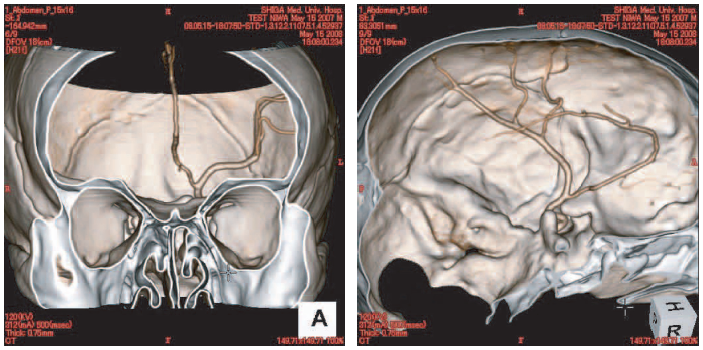Fantomas
A ABGT fornece uma gama completa de fantomas e modelos de treino para imagiologia médica, incluindo ultrassonografia, PET/SPECT, radioterapia e angiografia. Com fantomas realistas para treino e controlo da qualidade, estes produtos garantem precisão e fiabilidade, essenciais para otimizar processos clínicos e formação.
LUNGMAN – Fantoma de Tórax para Radiologia e Tomografia
O fantoma LUNGMAN é um modelo anatómico em tamanho real, preciso e de alta qualidade, destinado a radiologia convencional e tomografia computadorizada. Reproduz com exatidão a espessura e composição do tórax humano, com tecidos e ossos sintéticos que simulam fielmente a absorção de raios X.
- Radiografia: Permite imagens tridimensionais realistas em qualquer incidência, com contrastes fiéis de ossos e vasos.
- Tomografia Computadorizada: Posicionamento adequado para aquisição, possibilitando a identificação espacial dos vasos pulmonares e avaliação de sistemas automáticos de deteção.
- Placas Torácicas: Aumentam a espessura do tórax para simular diferentes volumes corporais, ajustando a absorção de radiação.
- Componentes para Radioisótopos: Compatível com fusão de imagens CT e PET, ideal para estudos avançados.
PBU-50 – Fantoma de Corpo Inteiro com Mobilidade Anatómica
O PBU-50 é um fantoma em tamanho real com estrutura anatómica detalhada e articulações móveis, ideal para treino em posicionamento, aquisição de imagem e avaliação de equipamentos.
- Mobilidade realista: Ombros, quadris, cotovelos e joelhos com amplitude de movimento semelhante à humana; possibilidade de posição “pernas de rã” e componentes destacáveis.
- Anatomia detalhada: Esqueleto sintético com trabéculas ósseas, pulmões com vasos, espaço mediastínico, fígado e rins.
- Materiais avançados: Tecidos simulados com resposta radiológica realista (densidades e unidades Hounsfield próximas às do corpo humano).
Construído com resinas técnicas e articulações reforçadas, o PBU-50 é uma ferramenta robusta para formação, planeamento clínico e testes da qualidade em imagem médica.
PBU-60 – Fantoma Anatómico de Corpo Inteiro com Órgãos Internos
O PBU-60 é um fantoma adulto em tamanho real, concebido para treino clínico, testes de imagem e avaliação de equipamentos, com mobilidade realista e anatomia interna detalhada.
- Mobilidade funcional: Articulações móveis (ombros, quadris, cotovelos, joelhos) e membros destacáveis; permite posicionamento em supinação e “pernas de rã”.
- Anatomia interna completa: Crânio, cérebro, coluna vertebral, pulmões com vasos, fígado com sistema porta, rins, pâncreas, bexiga, próstata, reto, entre outros.
- Aplicações: Ideal para formação, simulação clínica e testes de qualidade em radiologia e tomografia computorizada, com realismo anatómico e radiológico.
PBU-70 – Fantoma Pediátrico de Corpo Inteiro
O PBU-70 é um fantoma antropomórfico pediátrico, baseado no corpo de uma criança de 4 anos (105 cm), concebido para treino clínico, investigação e validação de imagem médica em idade pediátrica.
- Anatomia realista: Inclui esqueleto sintético, pulmões, fígado, rins e mediastino integrados em tecido mole com propriedades radiológicas semelhantes às do corpo humano.
- Mobilidade funcional: Articulações manipuláveis e desmontagem em 10 partes (cabeça, tronco e membros) para simulação de vários posicionamentos.
- Materiais avançados: Sem metais ou líquidos, utiliza resinas técnicas (uretano, epóxi e policarbonato) que replicam com precisão a absorção radiológica pediátrica.
Ideal para ensino, desenvolvimento de protocolos e testes em imagem pediátrica, com segurança e realismo anatómico.
Fantoma de Pélvis Feminina para Ultrassonografia
Fantoma para treino em ecografia ginecológica, com anatomia realista e capacidade para exames transvaginais e transabdominais.
- Versátil: Permite prática de exames nas duas vias de aquisição ecográfica.
- Didático: Inclui inserts com patologias simuladas como cancro endometrial, quistos, fibroses e gravidez ectópica.
- Realismo anatómico: Estrutura fiel da genitália externa e órgãos internos, ideal para treino técnico e diagnóstico.
- Imagem de elevada qualidade: Adequado para ensino e aperfeiçoamento em contextos clínicos exigentes.
Insert com patologia
Cancro endometrial, fibrose uterina, quisto dermoide do ovário, hemorragia na Bolsa/ Saco de Douglas.
Cancro endometrial, fibrose uterina, quisto dermoide do ovário, hemorragia na Bolsa/ Saco de Douglas.
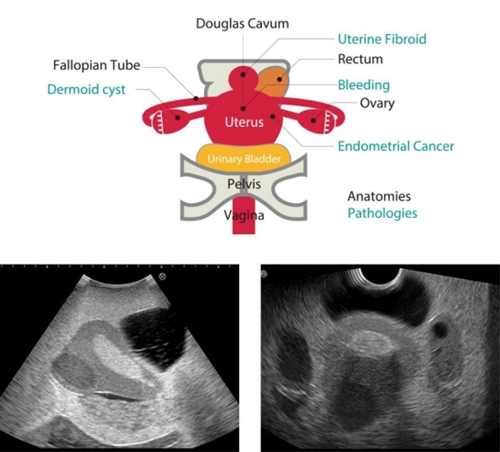
Insert de gravidez normal (7 semanas)
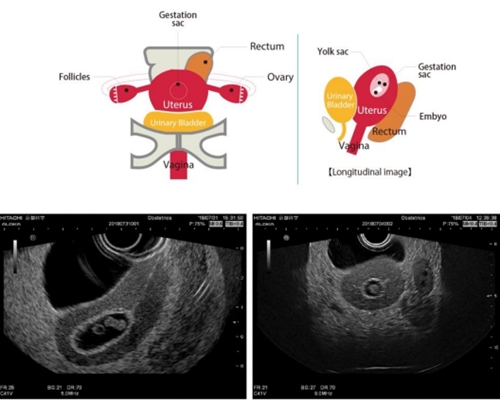
Insert de gravidez ectópica
Gravidez ectópica na trompa de Falópio, com hemorragia na Bolsa/saco de Douglas.
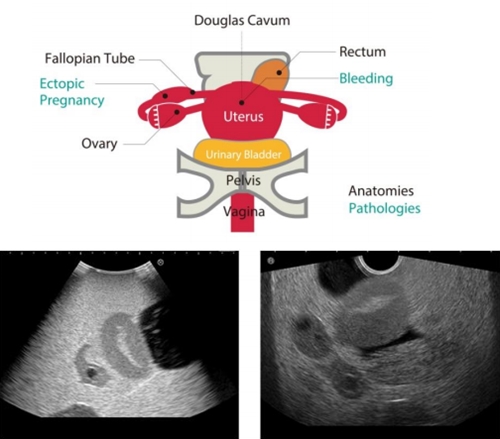
Competências de Formação
- Utilização e manuseamento de transdutores/sondas transvaginais e transabdominais.
- Interpretação imagiológica.
- Visualização e localização de anatomia e diferentes patologias.
Modelo de treino para ultrassonografia abdominal “ABDFAN”
Fantoma abdominal de alta qualidade para treino em ecografia clínica, com anatomia detalhada e simulação realista de patologias.
- Compatível com qualquer ecógrafo com sonda convexa.
- Representação fiel da anatomia hepatobiliar, pancreática, renal, esplénica e vascular.
- Permite treino nos oito segmentos hepáticos de Couinaud.
- Simulação de lesões realistas: quistos, tumores (hipo/hiperecóicos), cálculos biliares e tumor pancreático invasivo.
- Tamanho próximo do real e materiais duradouros, concebidos para uso intensivo em formação.
Ideal para desenvolver competências clínicas desde o ensino inicial até ao treino avançado em patologia abdominal.
Modelo de treino para ultrassonografia mamária "BREAST FAN"
Fantoma anatómico para formação em ecografia mamária, ideal para treino básico e identificação de estruturas normais e anormais.
- Simula com realismo o tecido mamário, ductos lactíferos, ligamentos, costelas, clavícula, músculo peitoral e pulmão.
- Inclui alvos com diferentes ecogenicidades, permitindo treino em deteção e caracterização de lesões.
- Gânglios linfáticos axilares visíveis para prática de avaliação regional.
- Materiais de alta qualidade e dimensões realistas (26×38×11 cm; peso ~7 kg).
Ferramenta essencial para formação técnica e clínica em ultrassonografia mamária.
Fantoma de ultrassonografia fetal "SPACEFAN-ST"
Fantoma fetal avançado para treino em rastreio ecográfico do 2.º trimestre de gravidez. Inclui um feto de 23 semanas com anatomia realista e esqueleto completo.
- Permite treino em biometrias fetais (BPD, AC, FL), avaliação anatómica e localização placentária.
- Útero simulador com líquido amniótico, placenta e cordão umbilical.
- Abdómen ajustável em quatro posições para treino versátil.
Anatomia fetal: cérebro com ventrículos e cerebelo, coração com 4 câmaras, pulmões, órgãos abdominais, sistema vascular e genitália externa.
Ferramenta essencial para ensino prático em obstetrícia e diagnóstico pré-natal.
Fantoma Torácico PET/SPECT
Fantoma anatómico para simulação de estudos PET e SPECT, ideal para treino e verificação de protocolos de imagem miocárdica e captação tumoral.
- Simulação de captação no miocárdio com diferentes concentrações de radiofármaco (RF), incluindo detecção de defeitos regionais.
- Inserção de tumores no fígado, pulmões e mama, com esferas preenchíveis para testar densidade, tamanho e localização.
- Permite fusão de imagens PET/SPECT com CT.
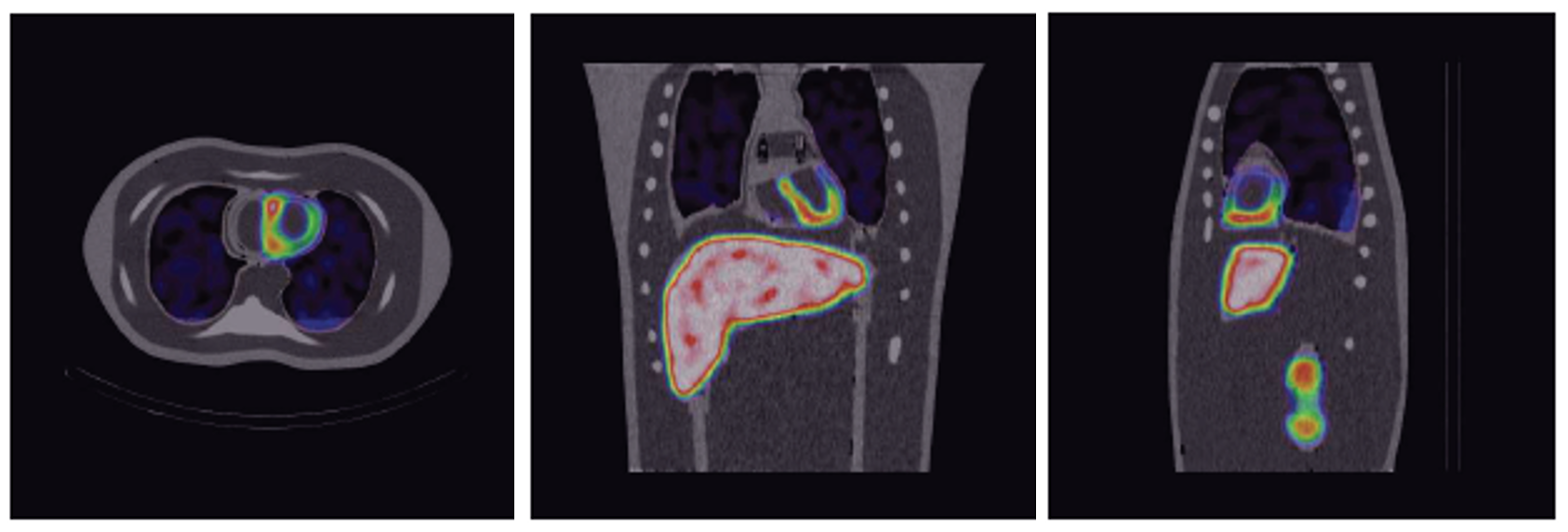
Anatomia simulada: coração (ventrículos e miocárdio), pulmões, fígado, rins e mama, com “hot spots” específicos para PET.
Ferramenta versátil para formação, QA e desenvolvimento de protocolos híbridos.

Fantoma antropomórfico THRA-1
O THRA-1 é um fantoma antropomórfico específico para utilização em dosimetria clínica uma vez que permite a utilização conjunta com dosímetros.
Este fantoma é composto por material equivalente aos tecidos moles, pulmão e osso.
O tamanho e espaçamento das inserções para os dosímetros e a espessura do corte podem ser personalizados.
Fantoma de Cabeça para Angiografia por TC (ACS)
O fantoma ACS foi desenvolvido para avaliação de imagens angiográficas por TC e serve também como ferramenta educativa para interpretação de imagens médicas.

- Simula diferentes densidades arteriais conforme a modalidade:
• Tomografia Computorizada (TC)
• Angiografia
• Tomografia por Emissão de Metais (METC) - Artérias cerebrais esquerdas com contraste tridimensional integradas no crânio, permitindo análises realistas e precisas.
Ideal para formação e validação de técnicas angiográficas por TC.
